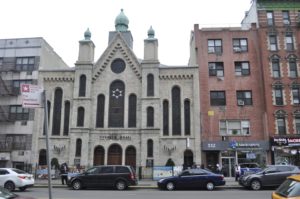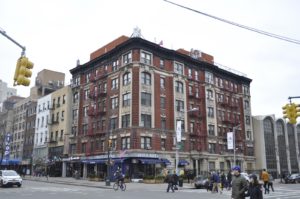Manhattan’s 14th Street is an eclectic mix of old and new, thrift and luxury. A heavily populated street during the day, and still lively at night, 14th Street offers food, entertainment and transportation. People from all walks of life cross paths, more often than not speed walking with their heads down to their next destination. It may come as a surprise that around the 1870s, 14th Street and Broadway was New York’s Theater District. All trace of the theaters has relocated uptown, but small remembrances of the era still grace the area. What follows are a series of “then and now” pictures, along with current pictures that document historical details. They show how the old resides within the new and are often overlooked during the chaotic bustle of everyday life.
140 E 14th St.



The Academy of Music was an opera house that opened in 1854 on the corner of 14th Street and Irving Place (where the current Raymour and Flanigan Furniture store is). It was demolished in 1926 and a movie theater with the same name was opened across the street in 1927 by William Fox. It became a rock concert venue in the 1960s and was renamed to Palladium. Today, the NYU dorm of the same name stands in the old Palladium’s place.
“I’ve heard a lot about how NYU bought, gentrified, and changed a lot of the Village, but this is one of the most dramatic examples I’ve seen. NYU dorms don’t add anything to the community like an iconic, historic music hall.” — Zoi Rosado, 21
133 E 14th St.

 Tammany Hall was a political institution founded in 1789. The Tammany Society, who met there, was an anti-Federalist group. The group played a major role in NY politics and in controlling the Democratic Party vote starting in the 1790s. The group is known for bringing charges of corruption against William M. “Boss” Tweed, who was convicted for embezzling millions of dollars from the city’s government. The building was demolished in 1926 (along with the Academy of Music) and replaced with the Consolidated Edison building. It is now the Raymour and Flanigan Furniture store.
Tammany Hall was a political institution founded in 1789. The Tammany Society, who met there, was an anti-Federalist group. The group played a major role in NY politics and in controlling the Democratic Party vote starting in the 1790s. The group is known for bringing charges of corruption against William M. “Boss” Tweed, who was convicted for embezzling millions of dollars from the city’s government. The building was demolished in 1926 (along with the Academy of Music) and replaced with the Consolidated Edison building. It is now the Raymour and Flanigan Furniture store.
“Even as a New York Democrat, I had no idea that this building was so important in the general elections for such a long time.” — Seth Loftis, 22
231 E 14th St.


The Italian Labor Center was built in 1919 and served as the headquarters for the Italian Ladies’ Garment Workers’ Union. Around this time, this area of the city was a little Little Italy. The relief carvings are thought to be done by poet and sculptor Onorio Ruotolo. The address now serves as the location of Beauty Bar, which has a dual function as beauty parlor and bar. The newer establishment still has the old Italian Labor Center facade.
“I heard about Beauty Bar through a BuzzFeed video, but it did not talk about the history of the building.” —Seth Loftis, 22
233 E 14th St.

This building, now the Blind Pig tavern, was home to the Edelstein Bros Pawn shop from 1945-1981. Isaac and Max Edelstein inherited the shop from their father, Simon Edelstein. The only sign of the original store is the banner at the very top of the building. It is almost impossible to see from the same side of the street.
334 E 14th St.

This building has a long religious history. It was built from 1866-1869 as the First German Baptist Center. In 1926 it became the Ukranian Orthodox Church. It is now the Tifereth Israel Town and Village Synagogue. The Landmarks Preservation Commission awarded it city landmark status in 2014.
14th Street and 2nd Avenue

0


The apartment house on the corner of 2nd Avenue and 14th Street was home to New York Senator William Maxwell Evarts in the 1800s. The building is one of the older styles on the block, and its entrance is inscribed with “NY Senate” and “WM Evarts” above the doorways.